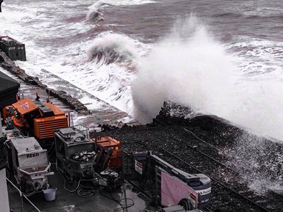West of Exeter Long Term Rail Route Planning
Following the disruptions in February 2014 to the West of England main line via Dawlish, leading to an eight week closure of the line, the government requested Network Rail produce the West of Exeter Route Resilience Study to consider options to avoid similar disruption in the future. See the full report from Network Rail here
 |
 |
 |
 |
Exeter to Newton Abbot
This report puts forward five possible options, three of which involve the creation of new lines to supplement the Dawlish route. The first of the three new line options investigates the viability of reinstating the former London & South Western Railway north of Tavistock, the second looks at the former Teign Valley Railway route. The third option proposes a ‘bypass’ of the Dawlish section of the line, providing increased capacity and also an alternative route should the Dawlish line become impassable again. The first two options pose problems for flooding and seem to be talked down by the reports. The third option suggests five possible routes between Alphington and Ware Barton, Dawlish and Ware Barton, Exminster and Bishopsteignton, and two between Exminster and Ware Barton.
Although no decisions have at this stage been made as to whether these options will be realised or which option might be preferred, those in the ‘catchment areas’ should consider the long term implications of their land or property holdings in these areas, and whether it would be prudent to obtain advice regarding their options, should a route over their land be chosen.
What’s next?
The West of Exeter Route Resilience Study (WoERRS) has been utilised as an input for the Western Route Study, another publication from Network Rail regarding UK long term rail network plans.
Despite the report’s conclusion that the options proposed in the WoERRS provide poor value for money, the wider impacts of the proposals are now being considered from a stakeholder perspective. Stakeholder views have not previously been assessed, and will look at the business cases for these options. In order to meet long term plans, set out in the 2043 Indicative Train Service Specification, it is suggested that the long term rail demands of the South West require a four track link between Exeter and Newton Abbot. This would be hard to achieve alongside the existing coastal route and therefore Network Rail are looking at the WoEERS options as an alternative.
Although the construction phase is some way off, and a route is yet to be chosen, some landowners might be prudent to consider their options sooner rather than later.
How can we help?
Early consultation with an acquiring authority can often mitigate the implications of a compulsory purchase order (CPO), making primary discussions highly important. Different CPO claimants will view these types of claims with different eyes, some may see it as an opportunity for income, whilst others may fear the confusion and legalities of the compulsory purchase process. On this basis it is vital to obtain advice at an early stage, to ensure you are aware of your options and what the future may bring if your land or property becomes subject to a CPO. In the end the amount of compensation is often determined by a well-argued case, constructed through a strong understanding of property values and assessments of the financial implications of the proposed scheme and the legislative framework of CPOs.
We can advise on the following aspects of compulsory purchase, both prior to and following the service of a CPO:
- Impact of a CPO and your rights;
- Preparing objections and representations to planning and CPOs;
- Seeking fee undertakings from acquiring authorities to mitigate financial burdens on landowners;
- Preparation of compensation claims;
- Negotiation of compensation settlements, both inside and outside the compulsory purchase procedure
and, if necessary, through the Upper Tribunal (Lands Chamber).
